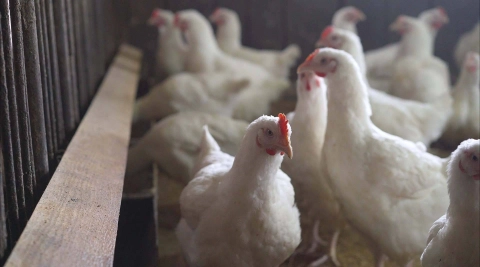Conditions Swine flu
On the one hand, swine flu refers to flu in pigs. It is very rare for humans to contract this. On the other hand, the term is also colloquially used to refer to a type of human flu that became known due to the pandemic in 2009.
At a glance
- The term “swine flu” can be used to refer to various medical conditions.
- On the one hand, swine flu refers to flu that affects pigs.
- In very rare cases, the flu viruses can be transmitted from pigs to humans.
- The swine flu pandemic is also used as a colloquial name for the major global flu pandemic in 2009.
- This pandemic was caused by a new strain of flu virus in humans, which showed genetic characteristics of the flu viruses that occur in pigs.
- The symptoms and treatment of both illnesses are similar to those of “ordinary” seasonal flu.
Note: The information in this article cannot and should not replace a medical consultation and must not be used for self-diagnosis or treatment.

What is swine flu?
The term “swine flu” can be used to refer to various medical conditions. It is important to distinguish between “zoonotic” influenza and the flu pandemic in 2009.
The term swine flu is firstly used to refer to the flu in pigs that is caused by influenza A viruses. In very rare cases, humans can contract the flu viruses from pigs and become ill. Infections primarily occur in pig farming due to close contact with the animals. If flu viruses are transmitted from an animal to a human and cause illness, this is known as zoonotic influenza.
On the other hand, the global flu pandemic in 2009 is colloquially known as the swine flu pandemic. This pandemic was caused by the then new flu virus Influenza A(H1N1)pdm09. This virus had genetic characteristics of swine flu viruses. It was therefore mistakenly referred to as swine flu. However, the illness was not contracted from pigs but instead transmitted from human to human like “ordinary” flu. The virus has since become one of the causes of seasonal flu outbreaks.
What are the symptoms of swine flu?
The symptoms of infection, both with flu viruses from pigs (zoonotic influenza) and with the influenza virus A(H1N1)pdm09 (“swine flu”) are generally mild. They are similar to those of ordinary flu. Some people do not have any symptoms at all. The symptoms usually appear a few days after infection and come on suddenly.
Common symptoms include:
- fever
- coughing, shortness of breath
- neck ache, headache and aching limbs
- in rarer cases: nausea, vomiting and diarrhea
Severe or fatal forms of the illness may develop in people with pre-existing conditions.
People who experience a severe form often develop pneumonia, which is sometimes complicated by an additional bacterial infection. Treatment in hospital may be necessary.
What causes swine flu?
Flu viruses are widespread among humans, birds and pigs. Despite this, the flu viruses occurring in pigs are still so different from those in humans that they only cause illness in people on very rare occasions. Whenever flu is transmitted from an animal to a human (zoonotic influenza), it is always caused by influenza A viruses. Infections only occur due to close contact with infected animals. Most people affected work in pig farming, in slaughterhouses or in veterinary practices.
If different flu viruses come together, they can exchange genetic information. This can happen more easily in pigs as they are not only susceptible to swine flu viruses but also to avian (bird) and human flu viruses.
Minor changes in the genetic information lead to slightly different flu variants appearing and causing seasonal flu outbreaks every year.
If, however, an entirely new virus combination occurs containing segments of animal flu viruses that can also spread in humans, this can lead to a flu pandemic. This was the case in 2009. The then new virus influenza A(H1N1)pdm09 triggered a major global flu outbreak. As the virus contains genetic characteristics of swine flu viruses, it was colloquially referred to as swine flu. In reality though, it was a human virus.
Which people are particularly at risk from swine flu?
Infection with flu viruses from pigs (zoonotic influenza) or the influenza virus A(H1N1)pdm09 (“swine flu”) usually only causes mild symptoms.
However, the following groups of people are at an increased risk of becoming more severely ill:
- Children under 5
- Adults over 65
- People who have been taking medication containing the active agent acetylsalicylic acid (ASA) for an extended period
- People whose immune defenses have been weakened due to an illness such as AIDS or as a result of medication that suppresses the immune system
- Pregnant women, especially those in the third trimester
- People with chronic conditions such as asthma, COPD, obesity, diabetes, heart disease or neuromuscular diseases
How common is swine flu in humans?
It is extremely rare for people to contract flu viruses from pigs (zoonotic influenza). Over 500 cases have been reported worldwide since the 1950s. Most of these cases have occurred in the USA since 2005. Several isolated cases of swine flu viruses in humans have also been recorded in Germany.
The then new virus Influenza A(H1N1)pdm09 led to a global “swine flu” pandemic in 2009. However, this was not transmitted from pigs to humans. The influenza A(H1N1)pdm09 virus is now a common cause of seasonal flu outbreaks.
What can be done to prevent swine flu?
There is no vaccine against flu viruses that are occasionally transmitted from pigs to humans (zoonotic influenza). Flu vaccines are unable to provide protection against newly combined flu viruses. New vaccines can only be manufactured once the composition of these viruses is known. As a result, the flu vaccine is adapted to the latest flu virus variants every year.
The outbreak of flu viruses in pigs can be prevented by:
- keeping pigs in the best possible conditions and creating a healthy housing climate
- vaccinating the animals against flu
- ensuring that any animals that may be infected do not have any contact with unvaccinated pigs or other farm or wild animals
- ensuring that workers who come into contact with live pigs receive a seasonal flu vaccine every year
Standard seasonal flu vaccines now contain the components of the virus that triggered the 2009 “swine flu” pandemic.
Further information on seasonal flu vaccination can be obtained from the Federal Institute of Public Health (Bundesinstitut für Öffentliche Gesundheit – BIÖG).
You can also use the vaccination checker tool provided by the Federal Institute of Public Health to find out if a flu vaccine is recommended for you.
Hygiene measures help to prevent infection with flu viruses.
For example, person-to-person transmission can be prevented by:
- coughing or sneezing into the elbow to minimize the amount of virus particles released into the air
- washing and sanitizing hands regularly
- disinfecting surfaces that may be contaminated with viruses
- avoiding contact with others when ill, staying home from work and avoiding use of public transport
How is swine flu diagnosed?
Flu is generally suspected if a person presents with typical symptoms that came on suddenly.
Doctors can perform a rapid test using a sample of fluid from the nose or a nasal and throat swab. However, this test only detects flu viruses; it does not distinguish between different subtypes.
Infection with a swine flu virus (zoonotic influenza) is suspected if a person shows typical symptoms of flu and has been in close contact with pigs. This mostly affects people who work with pigs as part of their job. Zoonotic influenza is particularly suspected if the symptoms occur outside the flu season.
Such suspected cases are reported to the local health authority and investigated more closely.
How is swine flu treated?
People can generally recover from flu at home. It is important to get plenty of rest and drink lots of fluids, especially in the case of a high temperature.
Antipyretic (fever-reducing) painkillers such as ASA, ibuprofen or paracetamol help to relieve headaches and aching limbs.
Important: Children with a high temperature should not be given medication containing the active ingredient acetylsalicylic acid (ASA). In rare cases, this can trigger a life-threatening side effect known as Reye’s syndrome.
If symptoms become significantly worse, medical treatment should be sought. If the illness is complicated by an additional infection with bacteria, antibiotics can be prescribed.
In some cases, doctors can use antiviral drugs to prevent the flu viruses from replicating. One example is the active ingredient oseltamivir. In the best-case scenario, the drugs will shorten the length of the illness. However, to have optimum effect, treatment must start within 48 hours of the first symptoms.
- Jilani TN, Jamil RT, Siddiqui AH. H1N1 Influenza. [Updated Mar, 04 2024]. In: StatPearls [Internet]. Treasure Island (FL): StatPearls Publishing; 2021 Jan-. Aufgerufen am 22.01.2025.
- Kalarikkal SM, Jaishankar GB. Influenza Vaccine. [Updated Jan 10, 2024]. In: StatPearls [Internet]. Treasure Island (FL): StatPearls Publishing; 2021 Jan-. Aufgerufen am 22.01.2025.
- Robert Koch-Institut (RKI). Epidemiologisches Bulletin 39/2011. Aufgerufen am 22.01.2025.
- Robert Koch-Institut (RKI). Infektionsepidemiologisches Jahrbuch meldepflichtiger Krankheiten für 2022. Berlin 2024. Aufgerufen am 24.01.2025.
- Robert Koch-Institut (RKI). Antworten des Robert Koch-Instituts auf häufig gestellte Fragen zur zoonotischen Influenza. Aufgerufen am 24.01.2025.
- Robert Koch-Institut (RKI). RKI-Ratgeber. Influenza (Teil 1): Erkrankungen durch saisonale Influenzaviren. Aufgerufen am 24.01.2025.
- Robert Koch-Institut (RKI). RKI-Ratgeber. Influenza (Teil 2): Erkrankungen durch zoonotische Influenzaviren. Aufgerufen am 24.01.2025.
Reviewed by the German Society of Virology (Gesellschaft für Virologie e.V. – GfV)
As at:





